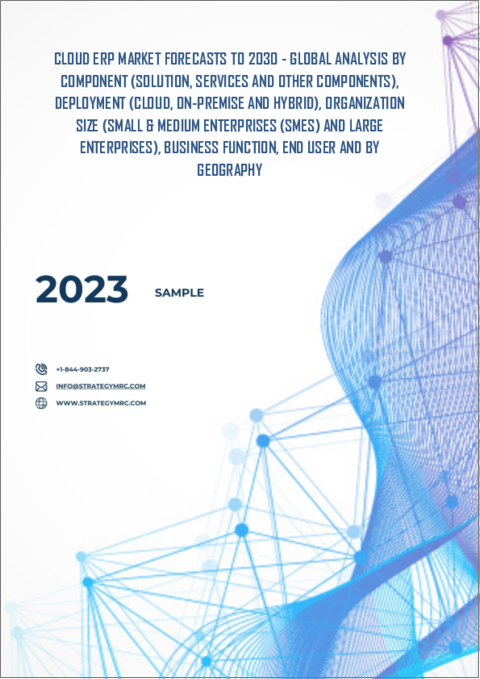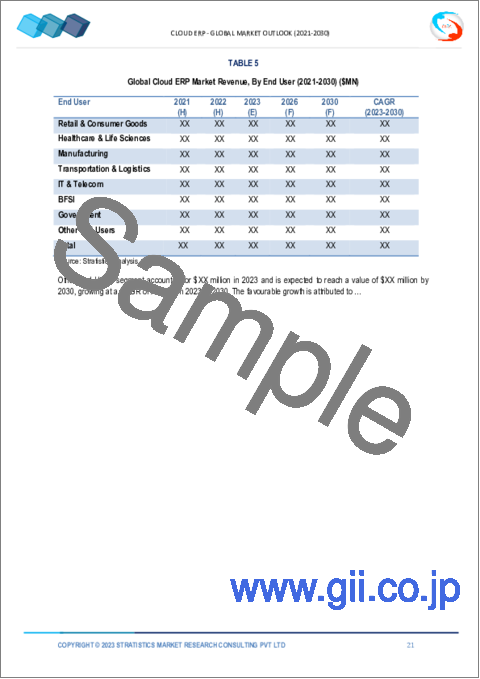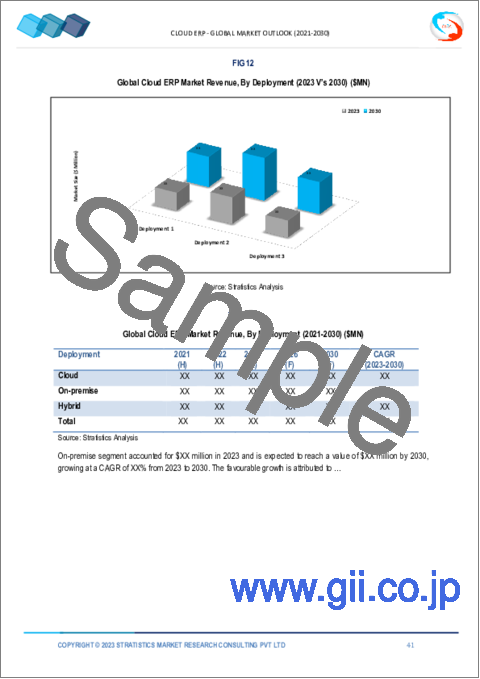|
|
市場調査レポート
商品コード
1308631
クラウドERP市場の2030年までの予測:コンポーネント別、展開別、組織規模別、事業機能別、エンドユーザー別、地域別の世界分析Cloud ERP Market Forecasts to 2030 - Global Analysis By Component, Deployment, Organization Size (Small & Medium Enterprises and Large Enterprises), Business Function, End User and By Geography |
||||||
カスタマイズ可能
|
|||||||
| クラウドERP市場の2030年までの予測:コンポーネント別、展開別、組織規模別、事業機能別、エンドユーザー別、地域別の世界分析 |
|
出版日: 2023年07月01日
発行: Stratistics Market Research Consulting
ページ情報: 英文 175+ Pages
納期: 2~3営業日
|
- 全表示
- 概要
- 図表
- 目次
Stratistics MRCによると、世界のクラウドERP市場は2023年に756億9,000万米ドルを占め、予測期間中のCAGRは17.0%で成長し、2030年には2,271億9,000万米ドルに達すると予測されています。
クラウドERPは、クラウドベースのプラットフォームを活用し、組織により柔軟なソリューションを可能にする企業管理ソフトウェアです。計画、生産、製品開発、マーケティング、販売の各プロセスはすべて、このプログラムによって統合されます。テクノロジーのおかげで、企業はより効率的に、多くの障壁なく運営することができます。製造、航空宇宙・防衛、IT・通信、小売、行政・公共部門、医療、銀行、その他の金融・保険サービスなど、幅広く採用されている分野はほんの一部に過ぎません。
2020年のIDCによると、世界のデジタル変革への投資は、中小企業や大規模組織による投資の急増により、1兆5,000億米ドルに達しました。
市場力学:
促進要因
先進技術の採用増加
企業業務の自動化のためにこれらの技術を採用するトップ企業による支出の増加は、AIベースおよびクラウドベースの企業資源計画ソフトウェアの受け入れの増加とともに、市場の拡大を促進します。主要市場参入企業は、人工知能(AI)、クラウドコンピューティング、機械学習などを含む最先端のソフトウェア技術に投資しています。企業にとって、このサービスはノートパソコンやモバイル機器からアクセスできます。Focus Xは、機械学習と人工知能によって推進される企業における予測分析と予測のためのアプリケーションで設計されています。前述の要素は、ERPソフトウェアの市場動向の一部とみなされています。
抑制要因:
オンプレミス展開モデルの統合の難しさ
企業は徐々にクラウドERPサービスとソリューションの統合を始めています。導入コストやシステムの複雑さのため、企業は新しいソリューションを現在のシステムに統合するのに多くの問題を抱えています。新しいクラウドベースのERPが適切に機能するためには、現在導入されている古いシステムと緊密に統合する必要があります。リソースの不足から、時代遅れのテクノロジーで構築された現在のシステムに頼っている企業も少なくないです。これらのシステムには、完了までに時間がかかり、エラーの可能性が高い手動プロセスが含まれています。
機会:
事業プロセスの合理化と業務効率化のニーズの高まり
海外で事業を展開する企業は、業務効率と企業手続きの透明性が求められるため、さまざまなビジネスモデルの採用を余儀なくされています。技術の進歩により、企業資源計画ソフトウェアシステムの複雑さが軽減され、サードパーティ製アプリで業務手順をより効果的に維持できるようになっています。販売やマーケティング、購買、サプライチェーン管理など、複数の企業プロセスを管理するために、組織は統合ソリューションを模索しています。ERPソフトウェアの導入は、企業プロセスを合理化し、改善しました。
脅威
カスタマイズの可能性が少ない
SaaSベースのクラウドERPソリューションとPaaSベースのクラウドERPソリューションは、ベンダーが提供する2つの異なるタイプのクラウドERPシステムです。クラウドベースのソリューションは、企業に柔軟性と拡張性を与えるが、その代償としてカスタマイズの可能性はほとんどないです。現時点では、SaaSベースのモデルには基本的な製品ラインに修正が含まれています。特に重要な機能に関して大幅な変更を要求する企業にとって、SaaSベースのERPでこのような変更を行うことは困難であり、その結果、企業のサービス提供が崩壊してしまいます。クラウドERPを提供する企業の大半は、人的資本管理(HCM)やCRMなどのアプリケーションを含んでいます。こうした制約はクラウドERPの導入に影響を及ぼし、市場の拡大に影響を与えると思われます。
COVID-19の影響:
多くの中小企業がデジタル技術を駆使して業務を自動化しています。例えば、土木エンジニアリング会社であるMacKay & Spositoは、2020年第2四半期のプロジェクトとその商業業務の計測に問題を抱えていました。その結果、同企業はERPソフトウェアシステムを利用して財務、プロジェクト、マテリアルハンドリングなどの様々な活動を処理し、その結果、キャッシュフローと収益性を改善しました。COVID-19の流行をきっかけに、デジタル技術プラットフォームの利用が拡大し、政府のデジタル化対策もあって、ERPソフトウェアの需要がやや高まっています。
予測期間中、中小企業(SME)セグメントが最大となる見込みである:
中小企業(SME)セグメントは、手頃な価格と新興技術の受け入れにより、有利な成長を遂げると推定されます。信頼性、拡張性、統合性、柔軟性、生産性の向上が、中小企業がクラウドシステム管理ソリューションを利用する主なメリットです。中小企業とは、従業員数が1~1,000人の企業を指します。企業運営を改善し、大手企業との競争に打ち勝つために、中小企業はクラウドERPシステムに投資します。中小企業は、クラウドERPシステムを使用して生産をスピードアップすることで、総生産性を向上させることができます。
予測期間中、CAGRが最も高くなると予想されるのはBFSIセグメントである:
BFSIセグメントは、予測期間中にCAGRが最も高くなると予測されています。銀行向け統合ERPソフトウェアが俊敏性とイノベーションを促進し、正確な予測を行うための洞察を引き出し、顧客が求めるエクスペリエンスを提供するからです。クラウドERPが顧客満足度と収益性を向上させることを考慮すると、銀行部門への統合は成長組織にとって賢明な行動です。安全なトランザクション、ライブ操作の監視、24時間365日のデータベースの更新とメンテナンス、銀行業務の適切な調査と評価などは、銀行向けクラウドERPソフトウェアが提供する重要な機能の一部です。
最大のシェアを占める地域
北米は、事業プロセスの効率性の向上により、予測期間中に最大の市場シェアを占めると予測されています。したがって、主要企業は、これらの技術から利益を得るために、迅速にクラウドERPシステムを使用しています。さらに、クラウドERPソリューションとERPを組み合わせることで、ソリューションの機能や性能が向上します。大手企業や中小企業がIoTや予知保全などの最先端技術と組み合わせた最先端のクラウドERPシステムの構築に注力する中、北米は市場拡大を促進すると予測されています。また、優れたITインフラとクラウドおよびモバイル技術の早期導入により、北米は運用コストが低いです。
CAGRが最も高い地域:
テクノロジーの市場開発と現地製造企業の台頭が欧州市場拡大の主な要因です。欧州委員会によると、ERPツールは、2019年には中小企業の30%、大企業の80%で使用されています。ドイツのクラウドERP市場の市場シェアが最も高く、英国のクラウドERP市場の地域別成長が最も速かっています。
主な発展
2022年8月、SAPはSAP S/4HANA Cloudを発表しました。このクラウドの目的は、SAPの顧客の事業プロセスを可能な限り自動化することです。RPAはこの変革の柱です。
2022年7月、Infotechは、エンタープライズリソースソリューションのサプライヤーであるSyntellisと協力し、医療消費者がSyntellis Axiom Healthcare Suiteにアクセスできるよう支援しました。このスイートは、企業の業務を強化するためのデータ主導の洞察を備えたEPMツールを提供します。
2022年2月、SAP SEとIBM Corporationは、ERPをクラウドに移行するために提携しました。
本レポートの内容
- 地域および国レベルセグメントの市場シェア評価
- 新規参入企業への戦略的提言
- 2021年、2022年、2023年、2026年、2030年の市場データをカバー
- 市場動向
- 市場推定に基づく主要ビジネスセグメントにおける戦略的提言
- 主要な共通トレンドをマッピングした競合情勢
- 詳細な戦略、財務、最近の動向を含む企業プロファイル
- 最新の技術的進歩をマッピングしたサプライチェーン動向
無料カスタマイズサービス:
本レポートをご購読のお客様には、以下のいずれかの無料カスタマイズオプションをご提供いたします:
- 企業プロファイル
- 追加市場プレイヤーの包括的プロファイリング(3社まで)
- 主要企業のSWOT分析(3社まで)
- 地域セグメンテーション
- 顧客の関心に応じた主要国の市場推計・予測・CAGR(注:フィージビリティチェックによる)
- 競合ベンチマーキング
- 製品ポートフォリオ、地理的プレゼンス、戦略的提携に基づく主要企業のベンチマーキング
目次
第1章 エグゼクティブサマリー
第2章 序文
- エグゼクティブサマリー
- ステークホルダー
- 調査範囲
- 調査手法
- データマイニング
- データ分析
- データ検証
- 調査アプローチ
- 調査ソース
- 一次調査情報源
- 二次調査情報源
- 前提条件
第3章 市場動向分析
- 促進要因
- 抑制要因
- 機会
- 脅威
- エンドユーザー分析
- 新興市場
- COVID-19の影響
第4章 ポーターのファイブフォース分析
- 供給企業の交渉力
- 買い手の交渉力
- 代替品の脅威
- 新規参入業者の脅威
- 競争企業間の敵対関係
第5章 クラウドERP世界市場:コンポーネント別
- ソリューション
- サービス
- プロフェッショナルサービス
- アドバイザリーサービス
- その他のコンポーネント
第6章 クラウドERPの世界市場:展開別
- クラウド
- オンプレミス
- ハイブリッド
第7章 クラウドERPの世界市場:組織規模別
- 中小企業(SME)
- 大企業
第8章 クラウドERPの世界市場:事業機能別
- 人的資本管理
- 顧客管理
- サプライチェーン管理
- 在庫・作業指示管理
- 財務管理
- その他の事業機能
第9章 クラウドERP世界市場:エンドユーザー別
- 小売・消費財
- 医療・ライフサイエンス
- 製造
- 輸送・物流
- IT・通信
- BFSI
- 政府
- その他エンドユーザー
第10章 クラウドERPの世界市場:地域別
- 北米
- 米国
- カナダ
- メキシコ
- 欧州
- ドイツ
- 英国
- イタリア
- フランス
- スペイン
- その他欧州
- アジア太平洋
- 日本
- 中国
- インド
- オーストラリア
- ニュージーランド
- 韓国
- その他アジア太平洋地域
- 南米
- アルゼンチン
- ブラジル
- チリ
- その他南米
- 中東・アフリカ
- サウジアラビア
- アラブ首長国連邦
- カタール
- 南アフリカ
- その他中東・アフリカ
第11章 主な発展
- 契約、パートナーシップ、提携、合弁事業
- 買収と合併
- 新製品の上市
- 事業拡大
- その他の主要戦略
第12章 企業プロファイル
- Microsoft
- Plex systems
- Ramco systems
- Odoo
- Tyler technologies
- Syspro
- Acumatica
- Deltek
- Openpro
- 3i Infotech
- QAD Inc.
- Sage software
- Oracle
- SAP
- Tally solutions
- Brightpearl
- IBM Corporation
- NetSuite Inc.
List of Tables
- Table 1 Global Cloud ERP Market Outlook, By Region (2021-2030) ($MN)
- Table 2 Global Cloud ERP Market Outlook, By Component (2021-2030) ($MN)
- Table 3 Global Cloud ERP Market Outlook, By Solution (2021-2030) ($MN)
- Table 4 Global Cloud ERP Market Outlook, By Services (2021-2030) ($MN)
- Table 5 Global Cloud ERP Market Outlook, By Professional Service (2021-2030) ($MN)
- Table 6 Global Cloud ERP Market Outlook, By Advisory Service (2021-2030) ($MN)
- Table 7 Global Cloud ERP Market Outlook, By Other Components (2021-2030) ($MN)
- Table 8 Global Cloud ERP Market Outlook, By Deployment (2021-2030) ($MN)
- Table 9 Global Cloud ERP Market Outlook, By Cloud (2021-2030) ($MN)
- Table 10 Global Cloud ERP Market Outlook, By On-premise (2021-2030) ($MN)
- Table 11 Global Cloud ERP Market Outlook, By Hybrid (2021-2030) ($MN)
- Table 12 Global Cloud ERP Market Outlook, By Organization Size (2021-2030) ($MN)
- Table 13 Global Cloud ERP Market Outlook, By Small & Medium Enterprises (SMEs) (2021-2030) ($MN)
- Table 14 Global Cloud ERP Market Outlook, By Large Enterprises (2021-2030) ($MN)
- Table 15 Global Cloud ERP Market Outlook, By Business Function (2021-2030) ($MN)
- Table 16 Global Cloud ERP Market Outlook, By Human Capital Management (2021-2030) ($MN)
- Table 17 Global Cloud ERP Market Outlook, By Customer Management (2021-2030) ($MN)
- Table 18 Global Cloud ERP Market Outlook, By Supply Chain Management (2021-2030) ($MN)
- Table 19 Global Cloud ERP Market Outlook, By Inventory & Work Order Management (2021-2030) ($MN)
- Table 20 Global Cloud ERP Market Outlook, By Financial Management (2021-2030) ($MN)
- Table 21 Global Cloud ERP Market Outlook, By Other Business Functions (2021-2030) ($MN)
- Table 22 Global Cloud ERP Market Outlook, By End User (2021-2030) ($MN)
- Table 23 Global Cloud ERP Market Outlook, By Retail & Consumer Goods (2021-2030) ($MN)
- Table 24 Global Cloud ERP Market Outlook, By Healthcare & Life Sciences (2021-2030) ($MN)
- Table 25 Global Cloud ERP Market Outlook, By Manufacturing (2021-2030) ($MN)
- Table 26 Global Cloud ERP Market Outlook, By Transportation & Logistics (2021-2030) ($MN)
- Table 27 Global Cloud ERP Market Outlook, By IT & Telecom (2021-2030) ($MN)
- Table 28 Global Cloud ERP Market Outlook, By BFSI (2021-2030) ($MN)
- Table 29 Global Cloud ERP Market Outlook, By Government (2021-2030) ($MN)
- Table 30 Global Cloud ERP Market Outlook, By Other End Users (2021-2030) ($MN)
Note: Tables for North America, Europe, APAC, South America, and Middle East & Africa Regions are also represented in the same manner as above.
According to Stratistics MRC, the Global Cloud ERP Market is accounted for $75.69 billion in 2023 and is expected to reach $227.19 billion by 2030 growing at a CAGR of 17.0% during the forecast period. ERP in the cloud is corporate management software that makes use of cloud-based platforms to enable organisations more flexible solutions. The planning, production, product development, marketing, and sales processes are all combined by the programme. Businesses may operate more efficiently and without many barriers thanks to technology. The manufacturing, aerospace and defence, information technology and telecommunications, retail, public administration and public sectors, healthcare, banking, and other financial and insurance services are just a few of the areas where it is extensively employed.
According to the IDC for 2020, the global digital transformation investment reached USD 1.5 trillion owing to a surge in investments by SMEs and large-scale organizations.
Market Dynamics:
Driver:
Rising adoption of advanced technologies
Increased expenditures by the top companies in adopting these technologies for automating corporate operations, together with increased acceptance of AI-based and cloud-based enterprise resource planning software, will fuel market expansion. Major market participants make investments in cutting-edge software technologies including artificial intelligence (AI), cloud computing, machine learning, and others. For businesses, this service is accessible on laptops and mobile devices. Focus X is designed with applications for predictive analysis and forecasting in enterprises that are driven by machine learning and artificial intelligence. The aforementioned elements are regarded as some market trends for ERP software.
Restraint:
Difficulties in on-premises deployment models integration
Businesses have gradually begun integrating cloud enterprise resource planning services and solutions. Due to installation costs and system complexity, businesses still have a lot of trouble integrating new solutions with their current systems. For the new cloud-based ERP to function properly, it must be tightly integrated with the older systems that are currently in place. A few businesses still rely on their current systems, which are built on antiquated technology, because to a lack of resources. They include manual processes that take longer to complete and have a higher chance of error.
Opportunity:
Growing need to streamline business processes and increase operational efficiency
Companies operating abroad have been compelled to adopt a variety of business models due to the requirement for operational efficiency and transparency in corporate procedures. Technology advancements reduce the complexity of Enterprise Resource Planning software systems and make it possible for third-party apps to more effectively maintain business procedures. To manage several company processes, including sales and marketing, purchasing, and supply chain management, organisations are searching for an integrated solution. The incorporation of ERP software has streamlined and improved corporate processes.
Threat:
Few customisation possibilities
SaaS-based and PaaS-based cloud ERP solutions are the two different types of cloud ERP systems that vendors provide. Cloud-based solutions give businesses flexibility and scale, but at the expense of few customisation possibilities. At the moment, SaaS-based models include modifications in their basic product line. Enterprises that demand substantial modification, particularly in relation to key capabilities, find it challenging to make these adaptations on SaaS-based ERP, which results in a company' service provision breaking down. Few suppliers provide a single suite of solutions that cater to the majority of customer needs; the majority of companies offering cloud ERP include apps, such Human Capital Management (HCM) or CRM. These restrictions have an effect on cloud ERP adoption and would have an influence on market expansion.
COVID-19 Impact:
Many small and medium-sized businesses have automated their business operations using digital techniques. For instance, the civil engineering company MacKay & Sposito had issues measuring the projects and its commercial operations in the second quarter of 2020. As a result, the business used an ERP software system to handle various activities, including finance, projects, and material management, and as a result, its cash flows and profitability. The COVID-19 epidemic has led to a growth in the use of digital technology platforms and government measures for digitalization, which has somewhat raised demand for ERP software.
The small & medium enterprises (SMEs) segment is expected to be the largest during the forecast period:
The small & medium enterprises (SMEs) segment is estimated to have a lucrative growth, due to due to affordability and acceptance of emerging technologies. Reliability, scalability, integration, flexibility, and increased productivity are the main advantages for SMEs to use cloud system management solutions. SMEs are defined as businesses with between one and one thousand employees. To improve their company operations and compete with major corporations, SMEs invest in cloud ERP systems. SMEs may increase their total productivity by using cloud ERP systems to speed up production.
The BFSI segment is expected to have the highest CAGR during the forecast period:
The BFSI segment is anticipated to witness the highest CAGR growth during the forecast period, as integrated banking ERP software promotes agility and innovation, draws insights to accurately anticipate, and provides the experiences customers demand. Considering that cloud ERP improves customer satisfaction and profitability, integrating it into the banking sector is a wise move for growing organisations. Secure transactions, live operation monitoring, 24x7 database availability with updates and maintenance, and appropriate research and assessment of banking operations are some of the crucial features that banking cloud ERP software provides.
Region with largest share:
North America is projected to hold the largest market share during the forecast period owing to the increased business process efficiency. Therefore, major businesses are quickly using cloud ERP systems in order to profit from these technologies. Additionally, the features or capabilities of the solutions are improved by combining cloud ERP solutions with ERP. As major corporations and small and medium-sized businesses concentrate on creating cutting-edge cloud ERP systems that are coupled with cutting-edge technology like IoT and predictive maintenance, North America is predicted to promote market expansion. Additionally, due to its superior IT infrastructure and early embrace of cloud and mobile technologies, North America has lower operating costs.
Region with highest CAGR:
Europe is projected to have the highest CAGR over the forecast period; owing to the development of technology and the rise of local manufacturing companies are the primary drivers of the expansion of the European market. Enterprise resource planning tools were used by 30% of small businesses and 80% of large organisations in 2019, According to the European Commission. The cloud ERP market in Germany had the highest market share, and the cloud ERP market in the UK had the fastest regional growth.
Key players in the market
Some of the key players profiled in the Cloud ERP Market include Microsoft, Plex systems, Ramco systems, Odoo, Tyler technologies, Syspro, Acumatica, Deltek, Openpro, 3i Infotech, QAD Inc, Sage software, Oracle, SAP, Tally solutions, Brightpearl, IBM Corporation and NetSuite Inc.
Key Developments:
In August 2022, SAP launched SAP S/4HANA Cloud, the aim of which is to automate SAP's customer's business processes wherever possible. Robotic Process Automation is a pillar of this transformation.
In July 2022, Infotech collaborated with Syntellis, a supplier of enterprise resource solutions, to assist healthcare consumers in accessing Syntellis Axiom Healthcare Suite. This suite offers EPM tools with data-driven insights for enhancing the company's operations.
In February 2022, SAP SE and IBM Corporation partnered to shift their enterprise resource planning (ERP) to the cloud.
Components Covered:
- Solution
- Services
- Other Components
Deployments Covered:
- Cloud
- On-premise
- Hybrid
Organization Sizes Covered:
- Small & Medium Enterprises (SMEs)
- Large Enterprises
Business Functions Covered:
- Human Capital Management
- Customer Management
- Supply Chain Management
- Inventory & Work Order Management
- Financial Management
- Other Business Functions
End Users Covered:
- Retail & Consumer Goods
- Healthcare & Life Sciences
- Manufacturing
- Transportation & Logistics
- IT & Telecom
- BFSI
- Government
- Other End Users
Regions Covered:
- North America
- US
- Canada
- Mexico
- Europe
- Germany
- UK
- Italy
- France
- Spain
- Rest of Europe
- Asia Pacific
- Japan
- China
- India
- Australia
- New Zealand
- South Korea
- Rest of Asia Pacific
- South America
- Argentina
- Brazil
- Chile
- Rest of South America
- Middle East & Africa
- Saudi Arabia
- UAE
- Qatar
- South Africa
- Rest of Middle East & Africa
What our report offers:
- Market share assessments for the regional and country-level segments
- Strategic recommendations for the new entrants
- Covers Market data for the years 2021, 2022, 2023, 2026, and 2030
- Market Trends (Drivers, Constraints, Opportunities, Threats, Challenges, Investment Opportunities, and recommendations)
- Strategic recommendations in key business segments based on the market estimations
- Competitive landscaping mapping the key common trends
- Company profiling with detailed strategies, financials, and recent developments
- Supply chain trends mapping the latest technological advancements
Free Customization Offerings:
All the customers of this report will be entitled to receive one of the following free customization options:
- Company Profiling
- Comprehensive profiling of additional market players (up to 3)
- SWOT Analysis of key players (up to 3)
- Regional Segmentation
- Market estimations, Forecasts and CAGR of any prominent country as per the client's interest (Note: Depends on feasibility check)
- Competitive Benchmarking
- Benchmarking of key players based on product portfolio, geographical presence, and strategic alliances
Table of Contents
1 Executive Summary
2 Preface
- 2.1 Abstract
- 2.2 Stake Holders
- 2.3 Research Scope
- 2.4 Research Methodology
- 2.4.1 Data Mining
- 2.4.2 Data Analysis
- 2.4.3 Data Validation
- 2.4.4 Research Approach
- 2.5 Research Sources
- 2.5.1 Primary Research Sources
- 2.5.2 Secondary Research Sources
- 2.5.3 Assumptions
3 Market Trend Analysis
- 3.1 Introduction
- 3.2 Drivers
- 3.3 Restraints
- 3.4 Opportunities
- 3.5 Threats
- 3.6 End User Analysis
- 3.7 Emerging Markets
- 3.8 Impact of Covid-19
4 Porters Five Force Analysis
- 4.1 Bargaining power of suppliers
- 4.2 Bargaining power of buyers
- 4.3 Threat of substitutes
- 4.4 Threat of new entrants
- 4.5 Competitive rivalry
5 Global Cloud ERP Market, By Component
- 5.1 Introduction
- 5.2 Solution
- 5.3 Services
- 5.3.1 Professional Service
- 5.3.2 Advisory Service
- 5.4 Other Components
6 Global Cloud ERP Market, By Deployment
- 6.1 Introduction
- 6.2 Cloud
- 6.3 On-premise
- 6.4 Hybrid
7 Global Cloud ERP Market, By Organization Size
- 7.1 Introduction
- 7.2 Small & Medium Enterprises (SMEs)
- 7.3 Large Enterprises
8 Global Cloud ERP Market, By Business Function
- 8.1 Introduction
- 8.2 Human Capital Management
- 8.3 Customer Management
- 8.4 Supply Chain Management
- 8.5 Inventory & Work Order Management
- 8.6 Financial Management
- 8.7 Other Business Functions
9 Global Cloud ERP Market, By End User
- 9.1 Introduction
- 9.2 Retail & Consumer Goods
- 9.3 Healthcare & Life Sciences
- 9.4 Manufacturing
- 9.5 Transportation & Logistics
- 9.6 IT & Telecom
- 9.7 BFSI
- 9.8 Government
- 9.9 Other End Users
10 Global Cloud ERP Market, By Geography
- 10.1 Introduction
- 10.2 North America
- 10.2.1 US
- 10.2.2 Canada
- 10.2.3 Mexico
- 10.3 Europe
- 10.3.1 Germany
- 10.3.2 UK
- 10.3.3 Italy
- 10.3.4 France
- 10.3.5 Spain
- 10.3.6 Rest of Europe
- 10.4 Asia Pacific
- 10.4.1 Japan
- 10.4.2 China
- 10.4.3 India
- 10.4.4 Australia
- 10.4.5 New Zealand
- 10.4.6 South Korea
- 10.4.7 Rest of Asia Pacific
- 10.5 South America
- 10.5.1 Argentina
- 10.5.2 Brazil
- 10.5.3 Chile
- 10.5.4 Rest of South America
- 10.6 Middle East & Africa
- 10.6.1 Saudi Arabia
- 10.6.2 UAE
- 10.6.3 Qatar
- 10.6.4 South Africa
- 10.6.5 Rest of Middle East & Africa
11 Key Developments
- 11.1 Agreements, Partnerships, Collaborations and Joint Ventures
- 11.2 Acquisitions & Mergers
- 11.3 New Product Launch
- 11.4 Expansions
- 11.5 Other Key Strategies
12 Company Profiling
- 12.1 Microsoft
- 12.2 Plex systems
- 12.3 Ramco systems
- 12.4 Odoo
- 12.5 Tyler technologies
- 12.6 Syspro
- 12.7 Acumatica
- 12.8 Deltek
- 12.9 Openpro
- 12.10 3i Infotech
- 12.11 QAD Inc.
- 12.12 Sage software
- 12.13 Oracle
- 12.14 SAP
- 12.15 Tally solutions
- 12.16 Brightpearl
- 12.17 IBM Corporation
- 12.18 NetSuite Inc.






